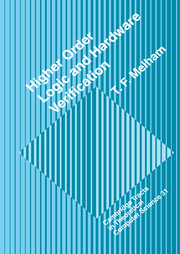2 - Higher Order Logic and the HOL System
Published online by Cambridge University Press: 21 January 2010
Summary
This chapter provides an overview of the formulation of higher order logic used in this book for reasoning about hardware. A brief account is also given of the mechanization of this logic in the HOL theorem proving system.
The version of higher order logic described in this chapter was developed by Mike Gordon at the University of Cambridge [41]. Gordon's version of higher order logic is based on Church's formulation of simple type theory [24], which combines features of the λ-calculus with a simplification of the original type theory of Whitehead and Russell [115]. Gordon's machine-oriented formulation extends Church's theory in two significant ways: the syntax of types includes the polymorphic type discipline developed by Milner for the LCF logic PPλ [48], and the primitive basis of the logic includes rules of definition for extending the logic with new constants and types.
The description of higher order logic given in this chapter is not complete, though it does cover all the aspects of the logic important to an understanding of later chapters. This book is concerned more with specifications than with proofs, and verification of theorems will be left mainly to the reader's logical and mathematical intuition. This chapter therefore deals mostly with notation. See Gordon's paper [41] or the HOL system manual [47] for a full account of higher order logic, including a list of the primitive rules of inference and a set-theoretic semantics.
- Type
- Chapter
- Information
- Higher Order Logic and Hardware Verification , pp. 9 - 28Publisher: Cambridge University PressPrint publication year: 1993



